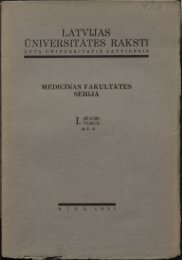ornamental sign language in the first order tracery belts - DSpace
ornamental sign language in the first order tracery belts - DSpace
ornamental sign language in the first order tracery belts - DSpace
Create successful ePaper yourself
Turn your PDF publications into a flip-book with our unique Google optimized e-Paper software.
Tenisons, M; Zeps, D. Ornamental Sign Language In The First Order Tracery Belts<br />
12. The belt produced from 10 asymmetric elements, us<strong>in</strong>g random number generator to choose between<br />
different seeds of chaos, accord<strong>in</strong>g pr<strong>in</strong>ciples expla<strong>in</strong>ed <strong>in</strong> this article. How about aes<strong>the</strong>tics <strong>in</strong> this example?<br />
We don’t have that simplicity that <strong>in</strong> case of Nica belt. Do we lack some more simple aes<strong>the</strong>tic pr<strong>in</strong>ciple here?<br />
Genesis of <strong>ornamental</strong> pattern: <strong>sign</strong> from code or vice versa<br />
In this article we expla<strong>in</strong>ed genesis of <strong>the</strong> <strong>ornamental</strong> <strong>sign</strong> from <strong>the</strong> side of code ra<strong>the</strong>r than<br />
from <strong>the</strong> side we perceive it as an image. Moreover, we may conclude that <strong>ornamental</strong> code<br />
may creep <strong>in</strong> <strong>in</strong>directly <strong>in</strong> o<strong>the</strong>r way too, e.g., via <strong>in</strong>strumental experience of weaver. Now<br />
we may question on more general level ask<strong>in</strong>g: how <strong>ornamental</strong> pattern arises? Via code or<br />
as an image? This question is not so redundant, because researchers of <strong>ornamental</strong> patterns<br />
use so much effort to expla<strong>in</strong> where from one or o<strong>the</strong>r pattern could have arisen, basically<br />
us<strong>in</strong>g “image approach”[2,7,8,9], because “code approach” would require some<br />
understand<strong>in</strong>g, how code generates <strong>sign</strong>. If we acknowledge that <strong>the</strong> code can generate an<br />
<strong>ornamental</strong> pattern as if from itself, <strong>the</strong> picture or this type of research changes card<strong>in</strong>ally. A<br />
new aspect comes before researchers – <strong>in</strong>strumental experience as source of producer of<br />
<strong>ornamental</strong> patterns.<br />
Belts of higher <strong>order</strong> and <strong>the</strong>ir eventual <strong>in</strong>vestigation<br />
We have already mentioned <strong>the</strong> belt of Lielvārde, that is much more complex than, say, <strong>the</strong><br />
belt of Nica. In <strong>order</strong> to research this type of belt it isn’t sufficient to remove sieve and apply<br />
asymmetry on some simple level. Belt of Lielvarde is build as if on several levels, a sieve if<br />
discernible, is used on several levels, scilicet, at least two. However, Lielvārde belt is<br />
produced by human be<strong>in</strong>gs, with <strong>the</strong>ir hands, though of very skilful masters. How to imag<strong>in</strong>e<br />
<strong>in</strong>vestigations of <strong>the</strong>se <strong>belts</strong> with exact methods similar we try to use <strong>in</strong> this article? Our<br />
answer is simple enough: we must <strong>first</strong> research <strong>first</strong> level <strong>belts</strong>, <strong>the</strong>n maybe nearest samples<br />
that step outside this <strong>first</strong> level. Moreover, we step as if <strong>in</strong> new typology of genesis of <strong>belts</strong>,<br />
scilicet, based on aris<strong>in</strong>g <strong>sign</strong> from code ra<strong>the</strong>r than as image. To support this approach we<br />
must apply new ma<strong>the</strong>matical methods along with <strong>the</strong>se already used <strong>in</strong> researches, as <strong>in</strong> [2].<br />
Modris Tenisons attributes Lielvārdes belt to fifth or even higher level of complexity, but he<br />
has no exact means to say what specifically; all this is still as if <strong>in</strong> <strong>the</strong> field of artistic<br />
14


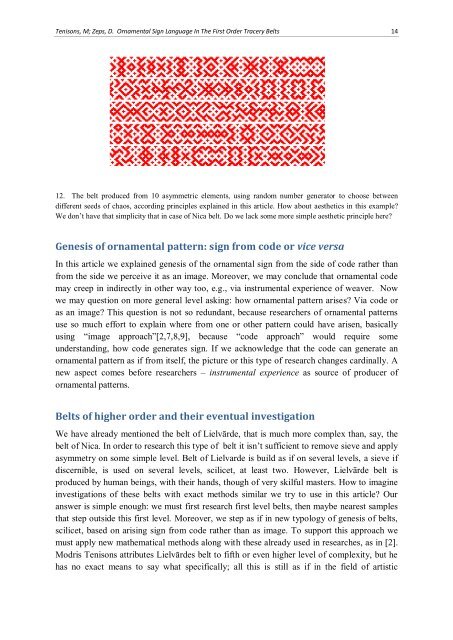

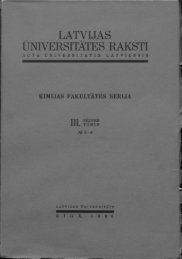
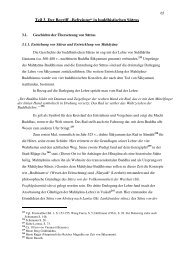
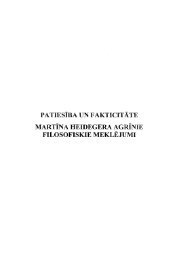
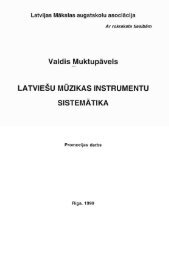
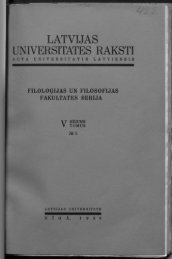
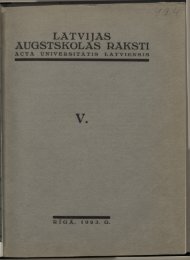


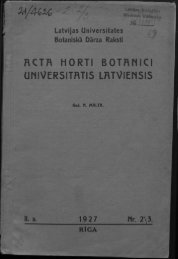
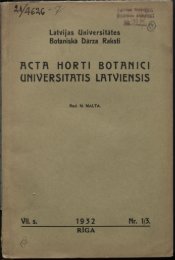
![LATVIJAS] - DSpace](https://img.yumpu.com/11778577/1/190x249/latvijas-dspace.jpg?quality=85)
